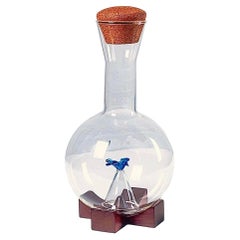Michael Graves Decanter
1990s Italian Post-Modern Barware
Blown Glass, Rosewood, Cork
People Also Browsed
1990s Italian Modern Tea Sets
Blown Glass
Late 20th Century American Post-Modern Games
Resin, Wood
Vintage 1970s American Modern Sofas
Rattan
1990s American Post-Modern Games
Velvet, Wood
Vintage 1960s Danish Mid-Century Modern Side Tables
Teak
Vintage 1960s Swedish Mid-Century Modern Carts and Bar Carts
Teak
2010s American Ottomans and Poufs
Zebra Hide
Vintage 1970s Italian Mid-Century Modern Decorative Boxes
Metal, Chrome
Vintage 1970s American Post-Modern Wall Clocks
Chrome
Vintage 1940s Argentine Neoclassical Screens and Room Dividers
Wood
Vintage 1960s Italian Mid-Century Modern Glass
Glass
Vintage 1980s Italian Post-Modern Beds and Bed Frames
Glass, Wood
1980s Contemporary Landscape Prints
Etching
Vintage 1950s Swedish Mid-Century Modern Delft and Faience
Ceramic, Faience
Mid-20th Century Brazilian Mid-Century Modern Animal Sculptures
Lucite
Mid-20th Century Italian Mid-Century Modern Table Lamps
Metal
A Close Look at Post-modern Furniture
Postmodern design was a short-lived movement that manifested itself chiefly in Italy and the United States in the early 1980s. The characteristics of vintage postmodern furniture and other postmodern objects and decor for the home included loud-patterned, usually plastic surfaces; strange proportions, vibrant colors and weird angles; and a vague-at-best relationship between form and function.
ORIGINS OF POSTMODERN FURNITURE DESIGN
- Emerges during the 1960s; popularity explodes during the ’80s
- A reaction to prevailing conventions of modernism by mainly American architects
- Architect Robert Venturi critiques modern architecture in his Complexity and Contradiction in Architecture (1966)
- Theorist Charles Jencks, who championed architecture filled with allusions and cultural references, writes The Language of Post-Modern Architecture (1977)
- Italian design collective the Memphis Group, also known as Memphis Milano, meets for the first time (1980)
- Memphis collective debuts more than 50 objects and furnishings at Salone del Milano (1981)
- Interest in style declines, minimalism gains steam
CHARACTERISTICS OF POSTMODERN FURNITURE DESIGN
- Dizzying graphic patterns and an emphasis on loud, off-the-wall colors
- Use of plastic and laminates, glass, metal and marble; lacquered and painted wood
- Unconventional proportions and abundant ornamentation
- Playful nods to Art Deco and Pop art
POSTMODERN FURNITURE DESIGNERS TO KNOW
- Ettore Sottsass
- Robert Venturi
- Alessandro Mendini
- Michele de Lucchi
- Michael Graves
- Nathalie du Pasquier
VINTAGE POSTMODERN FURNITURE ON 1STDIBS
Critics derided postmodern design as a grandstanding bid for attention and nothing of consequence. Decades later, the fact that postmodernism still has the power to provoke thoughts, along with other reactions, proves they were not entirely correct.
Postmodern design began as an architectural critique. Starting in the 1960s, a small cadre of mainly American architects began to argue that modernism, once high-minded and even noble in its goals, had become stale, stagnant and blandly corporate. Later, in Milan, a cohort of creators led by Ettore Sottsass and Alessandro Mendini — a onetime mentor to Sottsass and a key figure in the Italian Radical movement — brought the discussion to bear on design.
Sottsass, an industrial designer, philosopher and provocateur, gathered a core group of young designers into a collective in 1980 they called Memphis. Members of the Memphis Group, which would come to include Martine Bedin, Michael Graves, Marco Zanini, Shiro Kuramata, Michele de Lucchi and Matteo Thun, saw design as a means of communication, and they wanted it to shout. That it did: The first Memphis collection appeared in 1981 in Milan and broke all the modernist taboos, embracing irony, kitsch, wild ornamentation and bad taste.
Memphis works remain icons of postmodernism: the Sottsass Casablanca bookcase, with its leopard-print plastic veneer; de Lucchi’s First chair, which has been described as having the look of an electronics component; Martine Bedin’s Super lamp: a pull-toy puppy on a power-cord leash. Even though it preceded the Memphis Group’s formal launch, Sottsass’s iconic Ultrafragola mirror — in its conspicuously curved plastic shell with radical pops of pink neon — proves striking in any space and embodies many of the collective’s postmodern ideals.
After the initial Memphis show caused an uproar, the postmodern movement within furniture and interior design quickly took off in America. (Memphis fell out of fashion when the Reagan era gave way to cool 1990’s minimalism.) The architect Robert Venturi had by then already begun a series of plywood chairs for Knoll Inc., with beefy, exaggerated silhouettes of traditional styles such as Queen Anne and Chippendale. In 1982, the new firm Swid Powell enlisted a group of top American architects, including Frank Gehry, Richard Meier, Stanley Tigerman and Venturi to create postmodern tableware in silver, ceramic and glass.
On 1stDibs, the vintage postmodern furniture collection includes chairs, coffee tables, sofas, decorative objects, table lamps and more.
Finding the Right Barware for You
Whether it’s streamlined or sophisticated, a bar area is always a welcoming feature in any home interior. A cheery well-made drink with friends and family has the potential to yield some unforgettable moments alongside those that aren’t easily remembered. And the only way to conjure that exemplary cordial is by putting the proper antique or vintage barware to work.
Essential barware equipment ranges from sterling-silver barspoons for mixing your cocktails in tall collins glasses to jiggers, shakers and strainers that allow you to whip up martinis and old-fashioneds.
From a design standpoint, some barware, such as our array of Art Deco glass whiskey sets or mid-century modern silver-banded tumblers crafted by Dorothy Thorpe, can help position your bar as a bold and attractive centerpiece to a room. At the very least, a carefully curated collection of barware can elevate with subtlety the bar’s nearby fixtures, as a handcrafted crystal decanter might do for your vintage 1960s bar cart.
As cocktail hour draws near, find inspiration in our gorgeous gallery of home bars in locales ranging from London to New York to San Francisco, and browse the exquisite selection of antique, new and vintage barware and glassware on 1stDibs.
